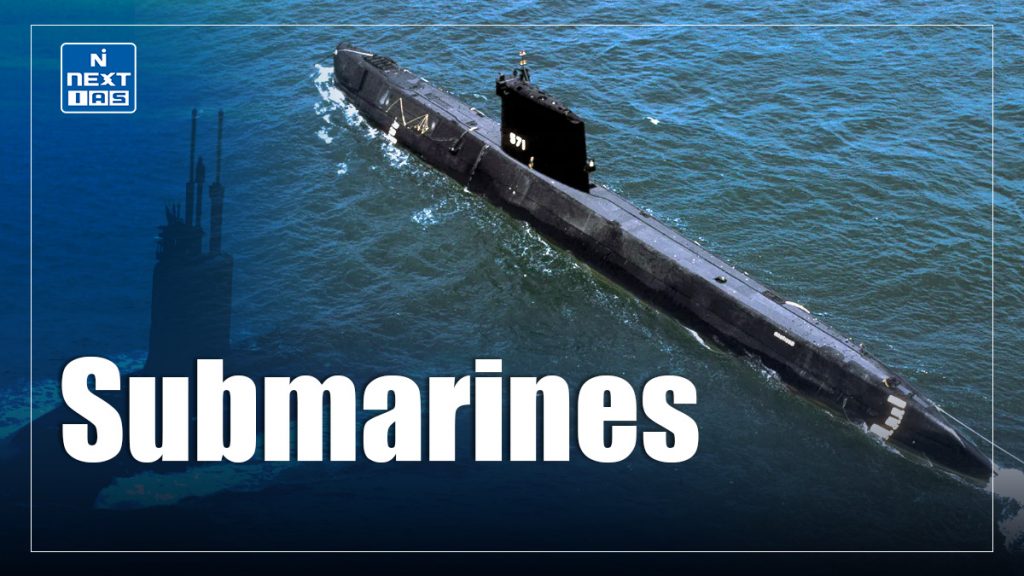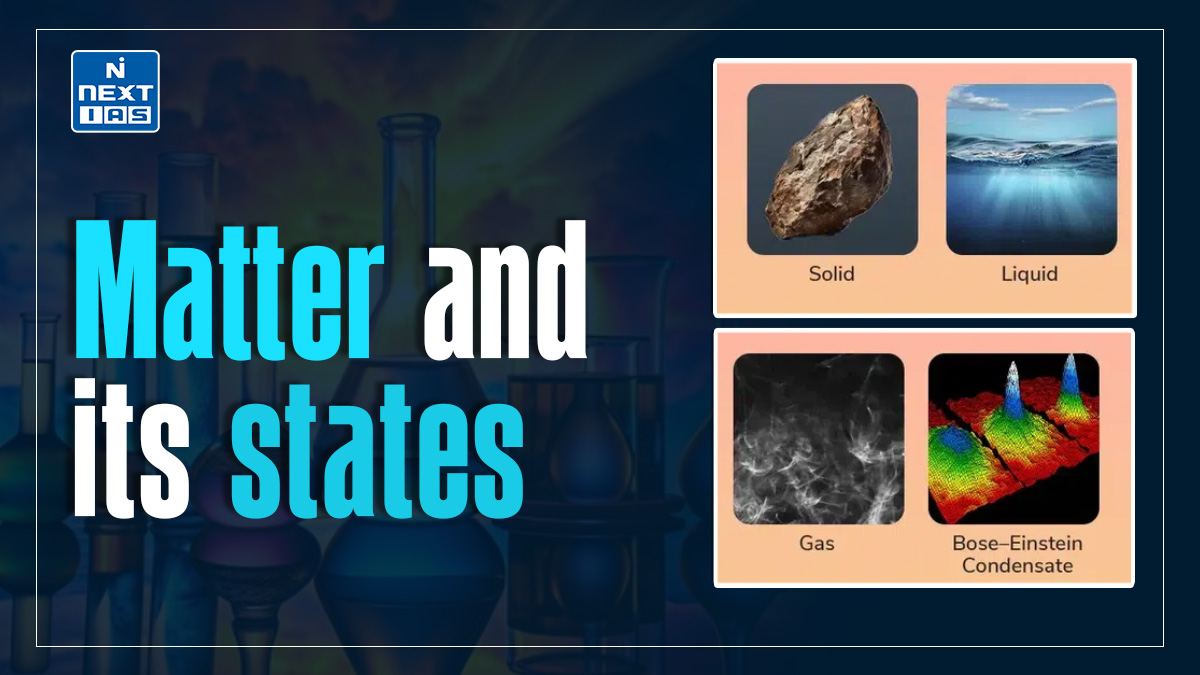
Submarines play a crucial role in naval warfare, enabling stealth operations, underwater reconnaissance, and strategic deterrence. Equipped with advanced weaponry and sonar technology, submarines enhance a nation’s maritime security by conducting covert operations, safeguarding territorial waters, and supporting nuclear deterrence through second-strike capabilities, making them vital assets in modern defense.
About the Submarines
- They are advanced naval vessels designed for underwater operations, providing stealth, mobility, and strategic deterrence.
- They are classified into attack submarines (SSN), ballistic missile submarines (SSBN), and cruise missile submarines (SSGN), each serving distinct roles.
- Attack submarines are equipped to target enemy ships and submarines, while SSBNs carry nuclear missiles, ensuring a nation’s second-strike capability in the event of nuclear war. SSGNs are capable of launching cruise missiles for precision strikes.
- They are powered by either nuclear or diesel-electric propulsion systems, with nuclear-powered submarines offering extended operational ranges and greater endurance.
- Their quiet operations allow them to avoid detection, making them vital for surveillance, intelligence gathering, and strategic deterrence.
- In modern navies, submarines are central to national defense, providing critical security and deterrent capabilities.
Types of Submarines
They are classified into various types based on their design, propulsion, and intended operational role. The main types include:
- Ballistic Missile Submarines (SSBN):
- Role: Serve as a strategic deterrent, carrying nuclear missiles capable of launching from underwater.
- Example: The U.S. Ohio-class, Russian Borei-class, and India’s Arihant-class.
- Attack Submarines (SSN):
- Role: Designed for offensive operations, including targeting enemy ships, submarines, and land-based assets.
- Powered by: Nuclear propulsion, offering extended operational range.
- Example: The U.S. Virginia-class, Russian Yasen-class, and India’s Scorpène-class.
- Cruise Missile Submarines (SSGN):
- Role: Carry cruise missiles for precision strikes against land and sea targets.
- Powered by: Usually nuclear-powered for greater endurance and range.
- Example: The U.S. Ohio-class converted to SSGN.
- Diesel-Electric Submarines (SS):
- Role: Primarily for coastal defense or short-range missions, powered by diesel engines and batteries.
- Example: The German Type 214, Japan’s Sōryū-class.
- Special Purpose Submarines:
- Role: Used for special operations, including intelligence gathering, reconnaissance, and insertion of special forces.
- Example: Nuclear-powered submarines modified for specific tasks, such as Russia’s AS-15 ‘Losharik.’
These different types provide nations with versatile underwater capabilities for both strategic deterrence and tactical operations.
Significance of Submarines
It holds immense strategic, tactical, and technological significance in modern warfare:
- Strategic Deterrence: Ballistic missile submarines (SSBNs) provide nations with a second-strike capability in a nuclear conflict, ensuring mutual assured destruction (MAD) and maintaining global security stability.
- Stealth and Surprise: Submarines operate undetected beneath the surface, making them ideal for intelligence gathering, covert operations, and surprise attacks, allowing nations to gather critical information or strike without warning.
- Force Projection: Submarines extend a nation’s military reach, allowing for rapid deployment of power across vast distances, especially in contested or strategic maritime regions.
- Naval Superiority: Submarines help maintain control over vital sea routes, defending against threats and denying access to adversaries, particularly in scenarios of naval blockades or territorial defense.
- Cost-Effective Warfare: Their stealth capabilities allow submarines to neutralize larger enemy forces with fewer resources, offering a cost-effective means of defense and offense in asymmetrical warfare.
- Global Influence: The possession of advanced submarines enhances a nation’s global stature, signaling technological and military prowess while strengthening international alliances.
Issues of Submarines
Submarines, while essential for naval defense, face several operational, technological, and strategic challenges:
- High Cost: Developing and maintaining submarines, especially nuclear-powered ones, is extremely expensive. This includes the cost of construction, operational upkeep, and the specialized training required for their crews.
- Vulnerability to Detection: Despite their stealth capabilities, submarines can still be detected by advanced sonar systems, acoustic signatures, or satellite surveillance, compromising their covert nature.
- Limited Lifespan: These, particularly nuclear-powered ones, have limited operational lifespans due to wear on reactors, pressure hulls, and other critical systems. Replacement and modernization programs are costly and time-consuming.
- Crew Fatigue and Safety: Its crews often spend extended periods underwater in confined spaces, leading to psychological stress, fatigue, and safety concerns, especially during deep-sea missions.
- Escalating Arms Race: The proliferation of advanced submarines, particularly nuclear-powered and nuclear-capable ones, could lead to a regional or global arms race, increasing tensions between nations.
- Environmental Concerns: Submarines, especially those powered by nuclear reactors, pose environmental risks, such as the potential for radioactive contamination if accidents occur or reactors are decommissioned improperly.
- Limited Communication: Operating underwater restricts communication to satellite links or buoy systems, which are vulnerable to jamming or interception, affecting real-time command and control.
- Technological Advancements: The rapid development of anti-submarine warfare (ASW) technologies—like advanced sonar systems, unmanned underwater vehicles (UUVs), and anti-submarine missiles—presents an ongoing challenge for submarine operations, requiring constant innovation and adaptation.
Way Forward
The future of submarines will be shaped by advancements in technology, strategic needs, and evolving threats. Key areas for development include:
- Nuclear Propulsion: The continued development of nuclear-powered submarines will enhance range, endurance, and operational flexibility. Smaller, more efficient reactors may make nuclear propulsion more accessible for smaller nations.
- Stealth and Signature Reduction: Advances in materials, hull designs, and noise reduction technologies will further enhance submarines’ stealth capabilities, making them harder to detect by sonar and other tracking methods.
- Automation and AI Integration: Increasing automation and AI systems will improve operational efficiency, reduce crew requirements, and enhance decision-making processes for underwater navigation, combat, and threat identification.
- Advanced Weaponry: It will be equipped with more sophisticated weaponry, including hypersonic missiles and advanced torpedoes, enabling them to strike from greater distances and with greater precision.
- Autonomous Submersibles: The development of unmanned underwater vehicles (UUVs) and autonomous submarines for reconnaissance, surveillance, and mine detection will complement manned vessels, reducing operational risk and enhancing operational scope.
- Collaborative Defense: Enhanced integration with other platforms, like aircraft and surface ships, will improve multi-domain operational effectiveness, ensuring submarines remain a key element of naval strategy and defense in future conflicts.
Conclusion
These are vital assets in modern naval warfare, providing unmatched stealth, strategic deterrence, and operational flexibility. With their ability to carry nuclear missiles, conduct surveillance, and strike precision targets, they enhance national security and defense.
Whether powered by nuclear or diesel-electric engines, submarines play a crucial role in maintaining maritime dominance and ensuring a credible second-strike capability. Their continued development and deployment are essential for safeguarding global peace and stability in an increasingly complex security environment.
Frequently Asked Questions (FAQs)
What are the 6 submarines under Project 75?
India’s Project 75 involves building six Scorpène-class submarines with French assistance. These include: INS Kalvari, INS Khanderi, INS Karanj, INS Vela, INS Vagir, and INS Vagsheer. Equipped with stealth features and advanced weaponry, they enhance India’s naval capabilities, focusing on anti-submarine warfare and intelligence-gathering missions.
Which is the first submarine of India?
India’s first submarine was INS Kalvari, commissioned on December 8, 1967. It was a Foxtrot-class submarine acquired from the Soviet Union, marking the beginning of India’s submarine fleet. Decommissioned in 1996, its legacy lives on with the new INS Kalvari, a Scorpène-class submarine inducted in 2017 under Project 75.
What is the difference between Project 75 and Project 75I?
Project 75 involves the construction of six Scorpène-class submarines with French assistance, focusing on conventional diesel-electric propulsion.
In contrast, Project 75I aims to build six conventional submarines with air-independent propulsion (AIP) technology, enhancing underwater endurance. Project 75I submarines will be more advanced, with improved stealth and capabilities.
What is the name of the fifth Scorpene submarine of Project 75?
The fifth Scorpène-class submarine under Project 75 is named INS Vagir. Commissioned in 2022, INS Vagir is a diesel-electric attack submarine designed for stealth, long-range missions, and equipped with advanced sonar and weapon systems.
It enhances the Indian Navy’s operational capabilities in underwater warfare.
How many submarines does the Indian Navy plan to build under project 76?
Under Project 76, the Indian Navy plans to build six nuclear-powered submarines. These submarines will be equipped with ballistic missiles and are intended to enhance India’s nuclear deterrence capabilities. The project is aimed at bolstering the nation’s strategic defense, with a focus on advanced nuclear propulsion technology.






